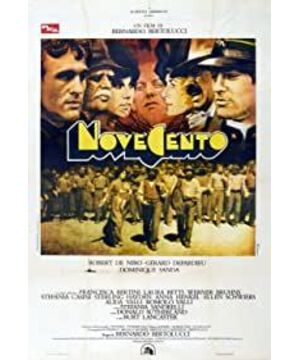"1900" is arguably the most ambitious epic in film history. It depicts a series of historical events and vividly reflects the vicissitudes of Italy experienced throughout the first half of the 20th century. It is like a magnificent historical picture, showing the quaint features of the author's hometown of Emilia and the hardships the people have gone through: the mechanization of agriculture, the establishment of trade unions, workers' strikes, the First World War, the rampant fascism, World War II, until the fall of fascism and the liberation of the people.
Although the film is 5 hours and 20 minutes long (the longest super film in the history of the world film), it does not make people feel long and procrastinating. On the contrary, its lyrical approach, poetic imagery, characters with distinct personalities, complex storyline and star-studded performances are all fascinating. No wonder it caused a stir when it appeared in Cannes, paralyzing the Cannes Film Festival for the entire day.
The background painting at the beginning of the film is an oil painting "The Proletariat" by the Italian painter Alberto. In the picture is just a sturdy farmer with a woman holding a baby on his right and another farmer on his left; behind the three are a large group of farmers. This is a masterpiece completed by the artist with four years of painstaking efforts.
As a member of the Italian Communist Party, Bertolucci wants to tell people that his work is a tribute to the proletarians, that is, to the victory of the peasants and their spokesman, the Communist Party. The author shows the audience the growth process of a proletarian and the victory of the guerrilla war led by the Communist Party through the experience of the tenant peasant child Olmo. But the author did not pit Olmo against his class enemy, Alfred Jr., and the two maintained a close friendship from childhood to old age. The reason why Bertolucci chose the descendants of the manor and the tenant farmers as the protagonists of the film has his moral. For Bertolucci, the working class represents the strength of men. Little Olmo, the sharecropper's child, even quipped that his genitals were longer than Alfred's because he was a socialist. But these two friends who have grown up together since childhood do not have any class prejudice, but can "learn from each other's strengths and complement each other's weaknesses". The fearlessness embodied in Olmo, such as lying on sleepers and catching frogs alive, was beyond the reach of little Alfred. It was only later that he learned these skills. In the end, when people were about to execute Alfred, it was Olmo who saved him. Bertolucci did indeed demonstrate his rather idealistic proletarian consciousness. This can be seen more clearly in the scene at the end of the film "peasants fight against landlords". After the film was released, the leaders of the Italian Communist Party at the time were quite dissatisfied, saying that "there is no such struggle in Italy". There is really no such struggle in Italy. Bertolucci admits that he "unconsciously reflected the form of rural class struggle in China into the film". Bertolucci has longed for China since he was a child. For him, the mysterious and glamorous China is like a dream. Perhaps, he reflected his dream of China into the film. A few years later, he directed "The Last Emperor", which can also be seen as another reflection of his "dream".
Bertolucci is an artist who strongly wants to make his works reflect his own subjective consciousness. In "1900", he reflects this history from his personal point of view. Therefore, the evolution of history and the opposing class struggle have become the "vehicles" of the author's subjective consciousness, rather than the objective and true reflection of history. .
There is a scene in the film where the people's armed forces are disbanded. It was April 25, 1945, and on the day of liberation, the guerrillas, in the name of an underground alliance of Catholics, liberals, socialists and communists, demanded that the peasants hand over their weapons. So the People's Armed Forces were disbanded, leaving the People's Party to rule the country. This can be called the first "historic compromise".
More than 20 years later, the General Secretary of the Italian Communist Party, Bellinger, formally proposed the "historic compromise" line in 1973, expressing his willingness to formally form a political alliance with the Democratic Party in order to achieve its "structural reforms without offending the ruling party." ”, the “Parliamentary Way” policy.
Bertolucci began filming the film in 1974, expressing this desire for a "compromise" at the end of the film, echoing the call of his party. We see the two protagonists, Alfred and Olmo, slapping each other affectionately, walking toward the boundless horizon in the midst of irrelevant squabbles.
However, the reason why the film attracted people's attention is because of its strong artistic appeal. There are many memorable scenes in the film, such as the death of old Alfred, the unique country ball, the funeral of the old man, the picnic under the row of willow trees, the death of Leo by the tree, the death of the train with the red flag. Departure...these sequences are full of true poetic quality, showing the superb artistry of director and cinematographer Storaro.
Bertolucci is so talented that he is often dubbed "Poetic Director" and "Psychological Director" by film critics. In his works, he focuses on exploring a style rich in original film language, not only good at describing the natural environment with poetic language, but also good at describing the psychological activities of characters with poetic language. The death of old Alfred is an example of this. It was a sunny and windy evening, and the stream was clear and gurgling. There were melodious flute and cheerful accordion sounds. In the clearing, the peasants danced. Old Alfred came with the hound. Looking at this beautiful scenery and listening to this music, he couldn't help but feel a crunch in his heart, lamenting that he was about to die and that he was out of tune with people. He said to himself: "How wonderful the music is around. The young people are dancing and falling in love in the sunset. The old people really shouldn't be here". So he went back to his cowshed. He rolled up his trousers, dipped his feet in the cow dung, and sucked the milk that the milkmaid had squeezed from the cow, and then said to her: "The dung is not bad, but the worst is that the brain is full of dung and milk. Whether it's war or corn spot disease, it's not abominable." After speaking, he asked the girl to dance, and asked her to announce to everyone that he was dead at the end of the meeting, and repeatedly told the girl: "You go and tell everyone, When I die, I have to continue dancing." After the girl left, he hung the chain on the beam and hanged himself. He returns to nature with a sense of contentment and self-deprecation. The author expresses very delicately the psychology of the manor owner, who has been ordering since childhood and roaring like a beast, finally died in self-reflection. In addition, the director's inner analysis of the character Ada is also very profound. Ada is a disillusioned city girl, drugged and empty inside, who becomes Ottavio's lover. After marrying little Alfred, she ran away from home because she couldn't bear her husband's soft-heartedness towards the fascist Atiler. She drank heavily every night and lived on the streets. The author expresses her distressed psychology of "no home but no home" and her romantic temperament in pursuit of women's liberation very touching. The combination of these lifelike characters and grand historical images makes "1900" the most epic and lyrical masterpiece of Western "political cinema" to date.
View more about 1900 reviews











